Event coding – LA Phil
Grouping events which have similar characteristics can transform your organisation’s approach to planning, forecasting, marketing and segmentation. We worked with LA Phil to develop a system that impacted on income and informed internal conversations.
The importance of events coding
When thinking about whether or not to purchase a ticket for an event every customer has a different reason for making that decision: when it’s on, who they’re going to go with, what seats are available (for performing arts), what the prices are (and offers available) and perhaps most important of all, what’s actually on stage or on the walls, i.e. the artistic offer.
Understanding that decision is key to making recommendations for strategy. However, while some elements of the decision are objectively different and can be consistently compared (e.g. Saturday night versus a weeknight), the artistic offer is decidedly more subjective and can vary dramatically across events. That’s why we need a system that we can apply consistently across all events to help us draw comparisons.
Grouping events which have similar characteristics (e.g. challenging vs light-hearted work) can help with a range of issues:
- Forecasting: to see what impact each grouping has on predicting final sales for an event.
- Setting prices and deciding on tactics, which is closely linked to forecasting (see Pricing Playbook).
- Segmentation (see Behavioural Segmentation): to identify different types of customer who prefer particular types of event, e.g. risk takers vs comfort seekers.
- Marketing approach: having understood which customers choose which types of event, marketing messages can be adjusted.
Applying events coding
There are two areas where data needs coding for analysis:
- Event type coding in relation to the range of programming you present: by type of production, e.g. in-house production, external promotion, touring event; by era, e.g. new work, established repertoire; by genre, e.g. musical, drama, dance; or whether it has some other niche appeal, either as a festive production or some other special event or gala performance.
- Repertoire coding, which is where the subjectivity kicks in as you make a judgement about the relative appeal of events in context of your market by breaking the event down into different elements. For example, a drama performance might be broken down into 5 components: popularity of ‘title’; popularity of ‘writer’; popularity of ‘director’; appeal of ‘cast’; buzz factor, each of which can be scored independently and then recombined to create an overall score for that performance.
Repertoire Scoring at the Los Angeles Philharmonic

In partnership with our colleagues at JCA Arts Marketing (formerly The Pricing Institute), we developed a repertoire scoring approach for the Los Angeles Philharmonic (LA Phil) for their Core Classical concerts. The aim was to create a system that the LA Phil team could use to help with forecasting, budgeting and pricing set-up. Our initial analysis uncovered that day of week, time of day and seasonality were not significant factors in understanding demand. This left us with programming as the key variable (along with the inclusion of concerts in a particular subscription series).
In collaboration with LA Phil we came up with three key programming factors that drive demand:
- The ‘hook’: the key identifying factor that offered the greatest appeal (e.g. concert title, composer, genre).
- The ‘support’: the impact of remainder of the repertoire in the concert.
- The artists: the effect the musicians and/or conductor had/did not have on the overall concert’s appeal.
Representatives from the LA Phil marketing, programming, and ticketing teams scored about 150 concerts over five seasons. Even though the LA Phil team had deep knowledge of the concerts, we asked them to do the scoring as if they had the knowledge and interest of an “average” LA Phil concert goer (e.g. neither aficionado nor novice).
LA Phil took the results of the scoring (ranging from the least appealing concerts at 0.5 to the most appealing at 6.0) and applied them to a pricing and marketing strategy.
Key findings and outcomes were as follows:
- Concerts with a score of 3.5 and higher had much less volatility in number of tickets sold.
- Subscribers were regularly exchanging out of lower scoring repertoire to higher scoring concerts; leaving the majority of spare single inventory for the lower-scoring concerts.
- Introduction of variable pricing of single tickets based on repertoire score and early demand for subscription sales:

- A 10% increase in potential gross for the season.
- Specially targeted offers to increase sales for lower scoring (i.e. less popular) concerts.
- Organization-wide discussions in relation to how to raise the average repertoire score while maintaining the LA Phil’s mission to present a variety of concerts.




